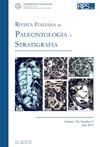阿尔卑斯山南部(意大利北部)的琥珀液滴:它们的出现与三叠纪主要潮湿事件之间的联系
IF 1.9
3区 地球科学
Q2 GEOLOGY
引用次数: 3
摘要
雷科罗地区Voltzia beds的Anisian琥珀由Voltzia recobariensis生产,代表了迄今为止已知的最古老的三叠纪琥珀。在多洛米蒂地区的Kühwiesenkopf/Monte Pràdella Vacca和Piz da Peres的阿尼西亚地区发现了琥珀,填补了琥珀化石记录的空白,并为三叠纪琥珀的研究做出了重要贡献。琥珀液滴的发现,既分散在沉积物中,又在解剖学上与雷切巴氏锥虫的枝条碎片相连,这表明在Anisian时期,该物种是树脂的主要生产者,并且在区域范围内存在保存树脂和植物遗骸的有利条件。Voltziales对意大利北部中三叠世树脂生产的贡献也通过Voltzia ladinica生产的温根/La Valle“Wengener Schichten”的Ladinian琥珀得到了证实,而晚三叠世琥珀主要由cheirolepidiacic针叶树生产。在Kühwiesenkopf/Monte Pràdalla Vacca的琥珀中发现了被困的有机体,这一发现值得注意,尽管很难解释,并再次表明它有能力诱捕和保存过去生命的目击者。此外,三叠纪琥珀的出现与区域/全球范围的湿度变化之间的对应关系表明了一种因果关系,其中琥珀生产/保存潜力的提高与气候/环境变化有关,特别是在边缘海洋/沿海环境中。本文章由计算机程序翻译,如有差异,请以英文原文为准。
AMBER DROPLETS IN THE SOUTHERN ALPS (NE ITALY): A LINK BETWEEN THEIR OCCURRENCES AND MAIN HUMID EPISODES IN THE TRIASSIC
The Anisian amber from the “Voltzia beds” of the Recoaro area, produced by Voltzia recubariensis, represents the most ancient Triassic amber known so far. The discovery of amber in the Anisian localities of Kühwiesenkopf/Monte Prà della Vacca and Piz da Peres, in the Dolomites area, fills a gap in the amber fossil record and gives an important contribution to the knowledge of Triassic amber. The finding of amber droplets, both dispersed in the sediment and anatomically connected to shoot fragments of V. recubariensis, demonstrates that during the Anisian this species was a major resin-producer and that the favorable conditions for the preservation of resin and plant remains were present at regional scale. The contribution of Voltziales to Middle Triassic resin production in Northern Italy is also testified by the Ladinian amber from the “Wengener Schichten” of Wengen/La Valle, produced by Voltzia ladinica, whereas the Late Triassic amber was mainly produced by cheirolepidiaceous conifers. The finding of organic body trapped in the amber of Kühwiesenkopf/Monte Prà dalla Vacca is noteworthy, although difficult to interpret, and shows once again its capability to entrap and preserve witnesses of past life. Moreover, the correspondence between the Triassic amber occurrences and regional/global scale humid shifts, suggests a cause-and-effect relationship, in which the rise of amber production/preservation potential is related to climate/environmental changes, particularly in marginal marine/costal environments.
求助全文
通过发布文献求助,成功后即可免费获取论文全文。
去求助
来源期刊
CiteScore
3.60
自引率
4.30%
发文量
28
审稿时长
>12 weeks
期刊介绍:
The Rivista Italiana di Paleontologia e Stratigrafia was founded in 1895. It publishes original papers dealing with all fields of paleontology and of stratigraphy, from Italy and the Mediterranean to the Tethys, as well across the globe from China to North America.

 求助内容:
求助内容: 应助结果提醒方式:
应助结果提醒方式:


